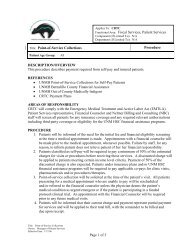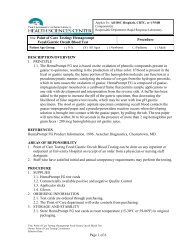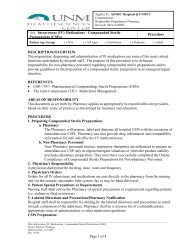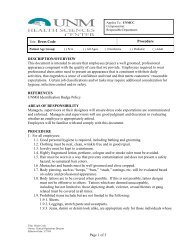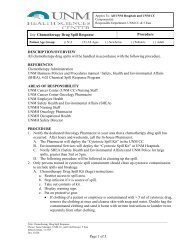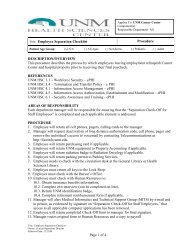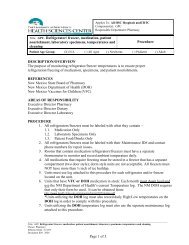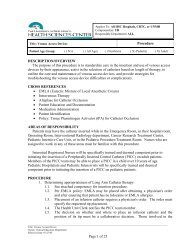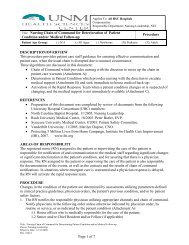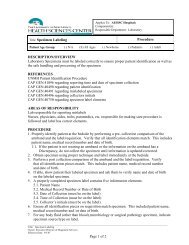(moderate) sedation in accordance with the following procedure.
(moderate) sedation in accordance with the following procedure.
(moderate) sedation in accordance with the following procedure.
Create successful ePaper yourself
Turn your PDF publications into a flip-book with our unique Google optimized e-Paper software.
3. Informed consent for <strong>the</strong> <strong>procedure</strong> and <strong>moderate</strong>/conscious <strong>sedation</strong> must be obta<strong>in</strong>ed<br />
prior to <strong>the</strong> <strong>in</strong>itiation of <strong>moderate</strong>/conscious <strong>sedation</strong> accord<strong>in</strong>g to <strong>the</strong> “Consents Invasive<br />
Procedure/Operative Policy”. This is accomplished after <strong>the</strong> practitioner has performed <strong>the</strong><br />
History and Physical (H&P) and is able to complete a Risk/Benefit analysis. Consent = Timeout<br />
requirement.<br />
4. Only RNs, GNs under supervision, Specialty Registered Respiratory Therapists <strong>with</strong> <strong>the</strong>ir<br />
expanded scope of practice, mid-level providers or physicians may adm<strong>in</strong>ister <strong>moderate</strong>/<br />
conscious <strong>sedation</strong> medication provided <strong>the</strong>y have current age-appropriate ALS certification<br />
and demonstrated <strong>moderate</strong> /conscious <strong>sedation</strong> competency.<br />
5. LPN’s may adm<strong>in</strong>ister PO/PR Chloral Hydrate and provide monitor<strong>in</strong>g for those patients,<br />
provided <strong>the</strong>y have current age-appropriate ALS certification and demonstrated <strong>moderate</strong><br />
/conscious <strong>sedation</strong> competency via <strong>the</strong> class or module and complete <strong>the</strong> annual on-l<strong>in</strong>e<br />
competency.<br />
6. The above mentioned qualified personnel manag<strong>in</strong>g <strong>the</strong> procedural care of <strong>the</strong> patient receiv<strong>in</strong>g<br />
<strong>moderate</strong>/conscious <strong>sedation</strong> should have no o<strong>the</strong>r responsibilities that would require leav<strong>in</strong>g<br />
<strong>the</strong> patient unattended or compromis<strong>in</strong>g cont<strong>in</strong>uous patient monitor<strong>in</strong>g dur<strong>in</strong>g <strong>the</strong> <strong>procedure</strong>.<br />
The qualified personnel adm<strong>in</strong>ister<strong>in</strong>g <strong>moderate</strong>/conscious <strong>sedation</strong> will report off to <strong>the</strong><br />
accept<strong>in</strong>g staff all of <strong>the</strong>ir patient care responsibilities for <strong>the</strong> duration of <strong>the</strong> <strong>procedure</strong> and<br />
recovery.<br />
7. In <strong>the</strong> follow<strong>in</strong>g situations, <strong>the</strong> physician should consider consultation <strong>with</strong> an anes<strong>the</strong>siologist<br />
prior to <strong>sedation</strong>:<br />
a. Patient does not fulfill NPO criteria and requires emergency diagnostic exam or<br />
<strong>procedure</strong>.<br />
b. Severe cardiopulmonary, neurological or o<strong>the</strong>r organ system disease, which may present<br />
a significant hazard <strong>with</strong> <strong>the</strong> adm<strong>in</strong>istration of <strong>sedation</strong>.<br />
c. Potential difficult airway management (i.e. distorted anatomy, obstructive sleep apnea,<br />
morbid obesity, micrognathia, immobilization of <strong>the</strong> head and neck).<br />
d. Patient tak<strong>in</strong>g medication that may adversely react <strong>with</strong> sedatives or analgesics (i.e.<br />
MAO <strong>in</strong>hibitors).<br />
e. Prior history of adverse reaction to <strong>sedation</strong> or anes<strong>the</strong>sia.<br />
8. Patients who score as an American Society of Anes<strong>the</strong>siology: Physical Status (ASA: PS) class<br />
4, 5 or E are not appropriate candidates for <strong>moderate</strong>/ conscious <strong>sedation</strong>.<br />
9. Patients who receive <strong>moderate</strong>/conscious <strong>sedation</strong> and require transfer off <strong>the</strong> floor for<br />
<strong>procedure</strong>s must be accompanied by appropriately tra<strong>in</strong>ed staff.<br />
EQUIPMENT (essential):All <strong>moderate</strong>/conscious <strong>sedation</strong> patients will be monitored <strong>with</strong> <strong>the</strong><br />
follow<strong>in</strong>g equipment:<br />
1. Non-<strong>in</strong>vasive blood pressure monitor<br />
2. Pulse oximetry<br />
3. Oxygen capability<br />
4. Suction capability<br />
5. Crash cart <strong>with</strong> age and size appropriate equipment is available on <strong>the</strong> unit/department where<br />
<strong>sedation</strong> is given.<br />
6. IV access (see age specific for pediatric exclusions)<br />
7. Reversal drugs, such as; Naloxone (Narcan), Flumazenil (Romazicon), Atrop<strong>in</strong>e<br />
8. Electrocardiographic monitor <strong>with</strong> defibrillator capability is required for all patients <strong>with</strong><br />
Title: Procedural Sedation - Conscious<br />
Owner: Procedural Sedation Committee<br />
Effective Date: 10/12/06



